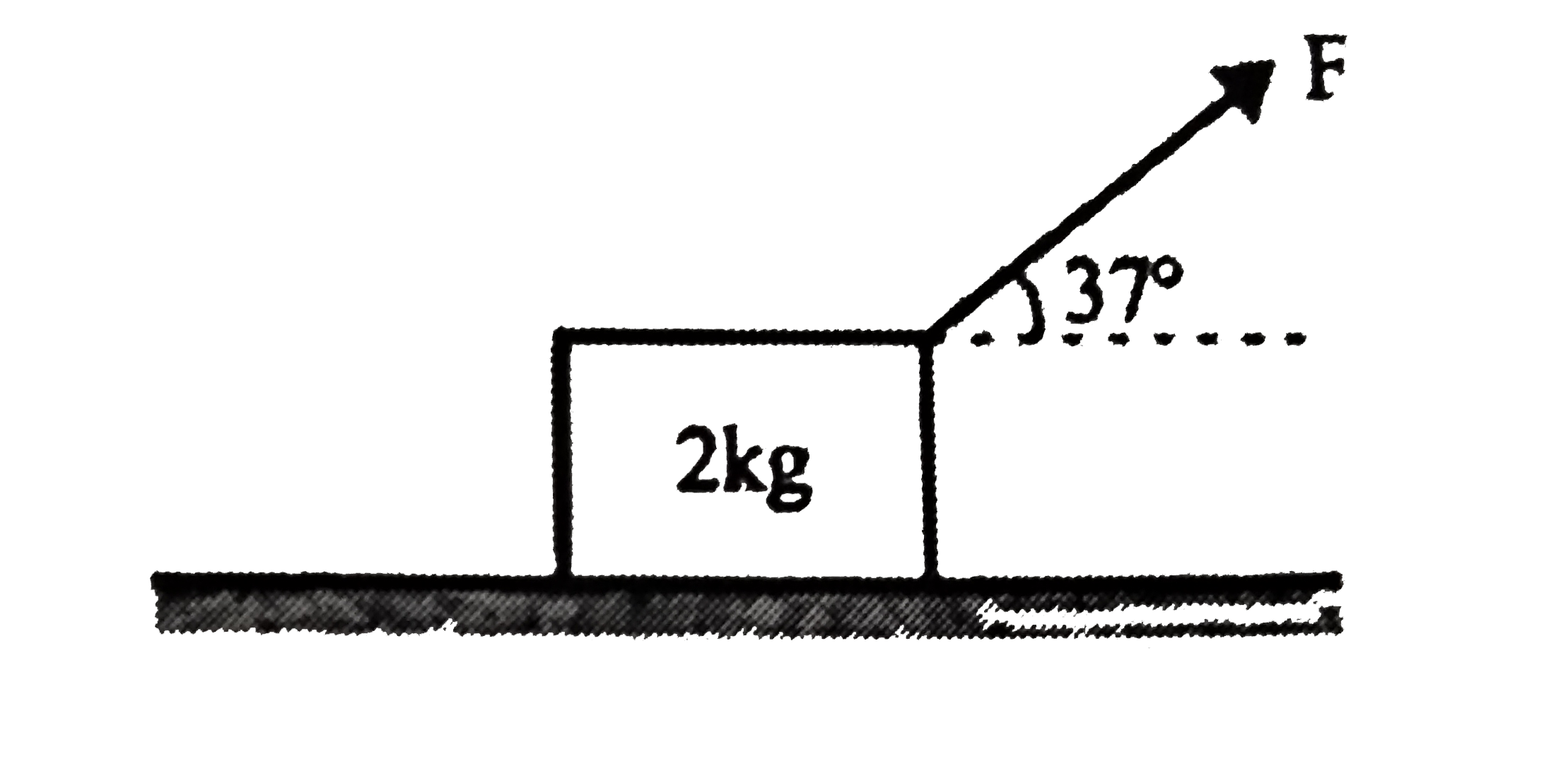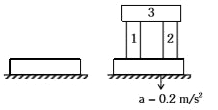A wooden block of mass 2 kg rests on a soft horizontal floor. When an iron cylinder of mass 25 kg is placed on top of the block, the floor yields steadily and the block and the cylinder together go down with an acceleration of0.1ms−2. What is the action of the block on the floor (a) before and (b) after the floor yields ? Take g = 10ms−2 . Identify the action-reaction pairs in the problem.
(a) The block is at rest on the floor. Its free-body diagram shows two forces on the block, the force of gravitational attraction by the earth equal to 2×x10=20N , and the normal force R of the floor on the block. By the First Law, the net force on the block must be zero i.e., R = 20 N. Using third law the action of the block (i.e. the force exerted on the floor by the block) is equal to 20 N and directed vertically downwards.
(b) The system (block + cylinder) accelerates downwards with 0.1ms−2 . The free-body diagram of the system shows two forces on the system : the force of gravity due to the earth (270 N), and the normal force R′ by the floor. Note, the free-body diagram of the system does not show the internal forces between the block and the cylinder. Applying the second law to the system,
270−R.=27×0.1N
i.e.,R.=267.3N

By the third law, the action of the system on the floor is equal to 267.3 N vertically downward
Topper's Solved these Questions
- LAW OF MOTIONBOOK - NCERT TELUGUCHAPTER - LAW OF MOTIONEXERCISE - EXERCISE
23 Videos
- LAW OF MOTIONBOOK - NCERT TELUGUCHAPTER - LAW OF MOTIONEXERCISE - EXERCISE (ADDITIONAL EXERCISE)
17 Videos
- KINETIC THEORYBOOK - NCERT TELUGUCHAPTER - KINETIC THEORYEXERCISE - ADDITIONAL EXERCISE
3 Videos
- MECHANICAL PROPERTIES OF FLUIDS BOOK - NCERT TELUGUCHAPTER - MECHANICAL PROPERTIES OF FLUIDS EXERCISE - EXERCISE
45 Videos
Similar Questions
A wooden block of mass 2 kg rests on a soft horizontal floor . When aniron cylinder of mass 25 kg is placed on top of the block , the floor yields steadily , and the block and the cylinder go down with an acceleration of 0.1ms−2 What is the action of the block on the floor (a) before and (b) after the floor yields ? Take g=10ms−2 . Identify the action reaction pairs in the problem .
View SolutionA wooden block of mass 2 kg rests on a soft horizontal floor . When aniron cylinder of mass 25 kg is placed on top of the block , the floor yields steadily , and the block and the cylinder go down with an acceleration of 0.1ms−2 What is the action of the block on the floor (a) before and (b) after the floor yields ? Take g=10ms−2 . Identify the action reaction pairs in the problem .
View Solution
Knowledge Check
Block A of mass 35 kg is resting on a frictionless floor.
 A0.8ms−2B2.4ms−2C0.4ms−2D4.4ms−2
A0.8ms−2B2.4ms−2C0.4ms−2D4.4ms−2A block of mass 2 kg is kept on a rough horizontal floor an pulled with a force F. If the coefficient of friction is 0.5. then the minimum force required to move the block is :-
 A10 NB10011NC1008ND20 N
A10 NB10011NC1008ND20 N
A wooden block of mass 1 kg rests on a soft horizontal floor. When an iron cylinder of mass 20kg is placed on top of the block, the floor yields steadily and booth go down with an acceleration of 0.1ms−2. What is the action of the block on the floor (a) before and (b) after the floor yields? (Take g=10ms−2). Identify the action and reaction pairs in the problem.

View SolutionA wooden block of mass 1 kg rests on a soft horizontal floor. When an iron cylinder of mass 20kg is placed on top of the block, the floor yields steadily and booth go down with an acceleration of 0.1ms−2. What is the action of the block on the floor (a) before and (b) after the floor yields? (Take g=10ms−2). Identify the action and reaction pairs in the problem.

View SolutionA steel block of 10 kg rests on a horizontal floor as shown. When three iron cylinders are placed on it as shown, the block and cylinders go down with an acceleration 0.2m/s2. The normal reaction R' by the floor if mass of the iron cylinders are equal and of 20 kg each, is ______ N. [Take g=10m/s2andμs=0.2]

View SolutionA force P acts on a smooth block of mass m placed on a horizontal floor at an angle θ with with horizontal on the block

View SolutionA block of mass 2 kg is placed on the floor (μ=0.4). A horizontal force of 7 N is applied on the block. The force of friction between the block & floor is fs. Find the fs.
View SolutionA block of mass 2 kg is kept on a rough horizontal floor an pulled with a force F. If the coefficient of friction is 0.5. then the minimum force required to move the block is :-

View Solution
